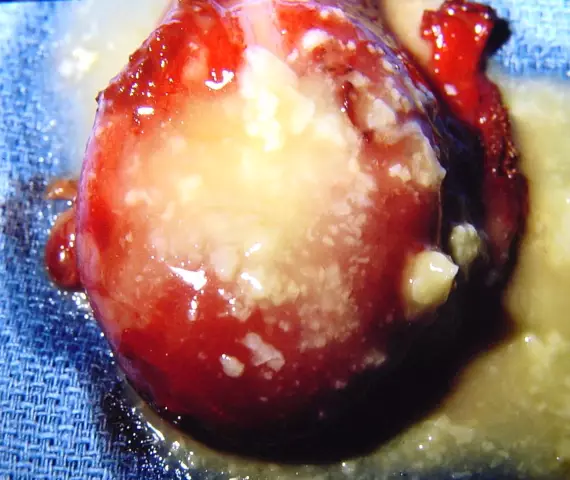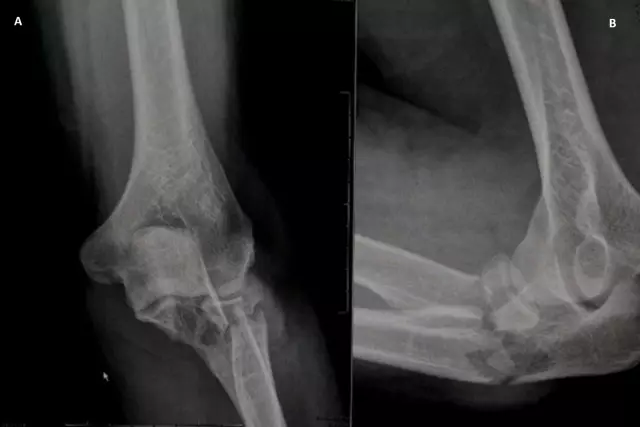- Author Rachel Wainwright [email protected].
- Public 2023-12-15 07:39.
- Last modified 2025-11-02 20:14.
Brachial bone
The humerus is the skeletal base of the shoulder, long tubular bone.

The structure of the humerus
The humerus consists of a body and two epiphyses - a distal lower and a proximal upper.
In the lower part of the body of the bone there is a posterior surface, bounded along the periphery by the medial and lateral edges, as well as by the lateral and medial anterior surfaces, separated by a slightly noticeable ridge.
On the medial anterior surface of the body, just below the midsection of the body, there is a feeding opening leading to a distally directed feeding channel.
On the lateral anterior surface, slightly above the feeding hole, you can see the deltoid tuberosity - the place where the deltoid muscle is attached.
Behind the deltoid tuberosity, on the posterior surface of the body, is the radial nerve groove.
The proximal pineal gland is somewhat thickened. On it is the hemispherical head of the humerus, facing upward, inward and slightly backward. From the rest of the bone, the periphery of the head is limited by a small constriction that runs in an annular fashion, the so-called anatomical neck. Somewhat below it, there are two hillocks - a small and a large one. Downward from each tubercle, the crest of the lesser tubercle and the crest of the greater tubercle, respectively, stretch. They are directed downward and reach the upper parts of the bone body. Together with the tubercles, they limit the well-defined intertubercular groove, in which the tendon of the long head of the biceps brachialis muscle is located.
On the border of the body and the upper end of the bone, slightly below the tubercles, there is a surgical neck - a slight narrowing corresponding to the area of the pineal gland.
The distal epiphysis is compressed anteroposteriorly. Its lower part is called the condyle of the humerus. The condyle consists of the head, to which the head of the radial bone is connected, and a block, which is connected in the elbow joint with the block-shaped notch of the ulna.
In front of the distal epiphysis, you can see the coronary fossa, above the head of the condyle - the radial fossa, and on the posterior surface - the fossa of the olecranon.
The peripheral parts of the lower part of the bone end in the medial and lateral epicondyles, from which the muscles of the forearm originate.
From each epicondyle along the distal part, the lateral and medial supracondylar ridges rise, respectively.
The medial epicondyle is more developed. On its back surface, you can see the groove of the ulnar nerve, and in front there is a protrusion - the supracondylar process, from which the radial flexor of the wrist begins.
The ulnar nerve groove and epicondyle are well felt under the skin and serve as bony landmarks.
Humerus fractures
There are the following types of fractures of the humerus:
- Head fracture;
- Intra-articular fracture (fracture of the anatomical neck);
- Extra-articular fractures (transtubercular fracture and fracture of the surgical neck);
- Fracture of the tubercle of the humerus.
Fractures of the head and anatomical neck of the bone occur, as a rule, as a result of a direct impact on the outer surface of the shoulder joint, or as a result of a fall on the elbow joint. This splits the head of the bone into several pieces.
The clinical picture of the fracture is characterized by the appearance of sharp pain. Due to edema, the shoulder joint increases, there is no way to make active hand movements. Passive movements are painful.
Fractures of the surgical neck of the humerus are divided into abduction (abduction) and adduction (leading).
An adduction fracture of the neck of the humerus occurs mainly when falling with an emphasis on an extended adducted arm, and an abduction fracture when falling with an emphasis on an extended abducted arm.
With a fracture of the neck of the humerus without displacement, the patient feels localized pain, which increases with axial load. In this case, the function of the shoulder joint is limited.
With a fracture with displacement, the patient feels sharp pain and pathological mobility. The function of the shoulder joint is disrupted, the axis of the shoulder is disrupted and shortened.
Fracture of the humerus tubercle most often occurs with dislocation of the shoulder or with an indirect mechanism of injury. The fracture occurs as a result of reflex contraction of the small round, infraspinatus and supraspinatus muscles. An isolated fracture of the tubercle of the humerus without displacement, as a rule, occurs as a result of a bruised shoulder.
With a fracture, patients experience localized pain and swelling of the soft tissues. Active movements cannot be carried out.
Found a mistake in the text? Select it and press Ctrl + Enter.






